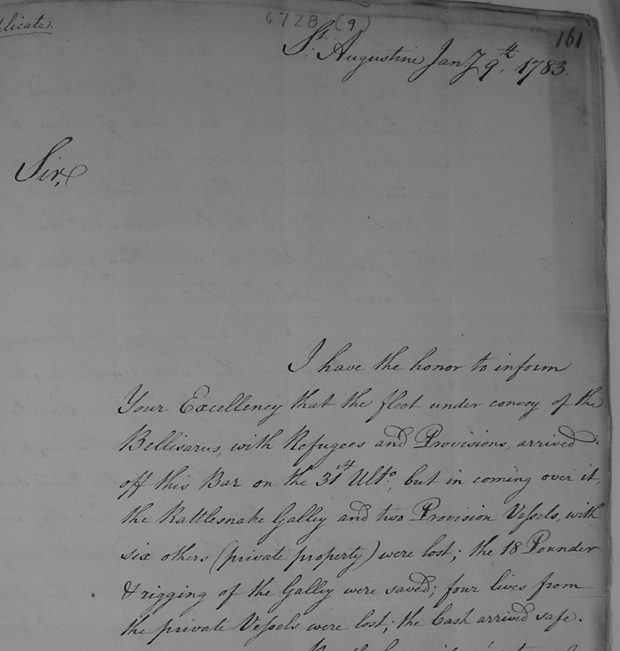
This letter, dated 9 January 1783, from East Florida’s British Governor, Patrick Tonyn, to the British Commander in Chief Sir Guy Carleton in New York, reports the loss off St. Augustine of the Rattlesnake, along with two victualing ships and six private vessels.
As I’ve blogged earlier, I recently made a trip to England where I spent four days immersed in dusty old volumes and sheafs of parchment, searching for clues to the identity of our shipwreck here off the coast of St. Augustine. Our PR specialist Steve Higgans put word out on the trip in the form of a press release, and it attracted some attention both near and far.
From Jacksonville’s newspaper, Florida Times-Union:
Chuck Meide let his fingers do the walking through Britain’s National Archives, and the trip shed new light on the ship that probably wrecked off St. Augustine toward the end of the Revolutionary War in 1782.
But while the recent document search gave a new clue to the mystery ship’s identity, the St. Augustine Lighthouse and Museum’s archaeology director also found another that says it shouldn’t have been anywhere near St. Augustine.
The overseas search through hundreds of 18th century documents was prompted by last fall’s discovery of a corroded uniform button with “71” on it from the shipwreck off the nation’s oldest city. It’s from the uniform of a member of Scotland’s 71st Regiment, aka Fraser’s Highlanders, who were assigned to the 1782 British Loyalist fleet that fled Charleston in advance of American soldiers. Some of that fleet wrecked that New Year’s Eve off St. Augustine.
Meide researched ship logs, military letters and other documents in England to find an answer — and found more questions. For one, the ship the Sally is the best possibility but was supposed to evacuate Loyalists to Jamaica, not Florida.
“The Sally is the top candidate, but it is still a bit iffy,” Meide said. “The Sally seems like she was a bit too big at 317 tons. If she was fully loaded there was no way she could get into St. Augustine. Maybe they thought they could risk it. … Maybe there was an emergency and she sprung a leak.”

This document names the Sally, under Captain Bell, as the vessel carrying the remaining soldiers of the 71st Regiment in the final evacuation fleet to leave Charleston in December 1782.
The story was not just picked up by the local paper, the St. Augustine Record (though it does not appear to be online) and the Times-Union, but by a number of other news outlets, including MarineLink.com and SeaDiscovery.com. You can also check out the original press release here.
Back to the Times-Union:
“We have lists of 129 ships hired by the army to evacuate Charleston and probably a lot more that are not listed on that,” Meide said. “We need to start comparing lists to see if we see ships on more than one.”
Meide says he’d like to check Lloyd’s Of London insurance records to find 1782 shipwrecks in Florida. More research may show if members of the 71st Regiment could have been assigned to other evacuation ships as protection against privateers, he said.
As reporter Dan Scanlan wrote, we were not 100% sure that our ship was the Sally, even though we know we had a button from one of the regiment’s soldiers on the wreck. It seemed possible that some soldiers might have been assigned to other ships, to provide protection against privateers, or perhaps hospitalized soldiers were sent to the closest friendly port, St. Augustine. One way to perhaps eliminate the Sally as a candidate for our shipwreck was to locate her insurance records in Lloyd’s List, published by the marine insurance company Lloyd’s of London. Well, we did so, and have already made a discovery–the sailing vessel Sally, captained by W. Bell, which appears to be the same vessel assigned to carry the 71st from Charleston to Jamaica, was indeed insured by Lloyd’s. We found her records for 1782, and also for 1783 and 1784 and subsequent years–this vessel, therefore, cannot have wrecked in St. Augustine in 1782, and therefore cannot be the identity of the Storm Wreck!
Another clue, another step closer to identifying the Storm Wreck!
Click here to visit the official webpage of the Storm Shipwreck excavation

